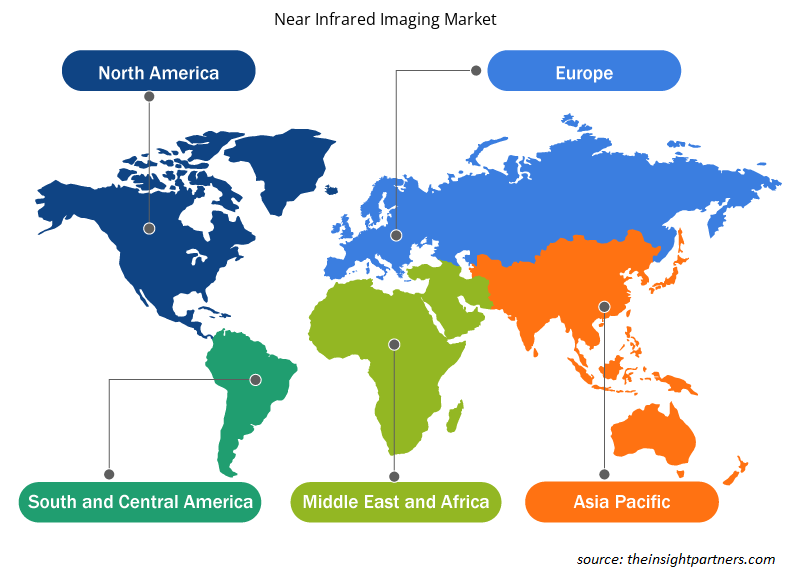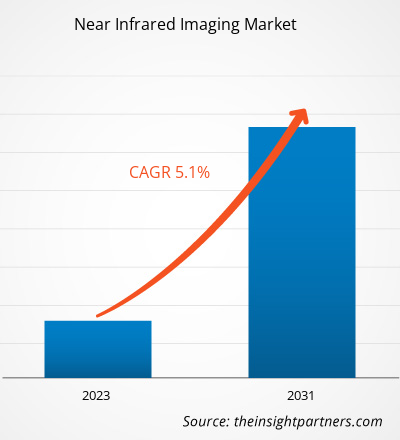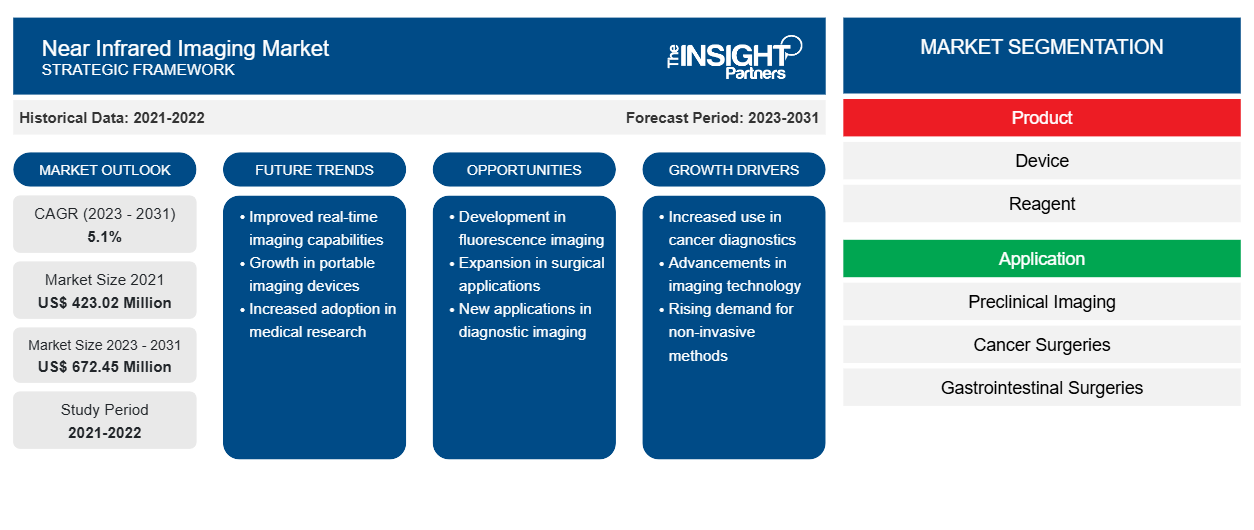Si stima che il mercato dell'imaging nel vicino infrarosso abbia raggiunto i 423,02 milioni di dollari nel 2021 e i XX milioni di dollari nel 2023 e si prevede che raggiungerà i 672,45 milioni di dollari entro il 2031; si stima che entro il 2031 registrerà un CAGR del 5,1%. È probabile che il consolidamento rimanga una delle tendenze chiave del mercato dell'imaging nel vicino infrarosso.
Analisi del mercato dell'imaging nel vicino infrarosso
La domanda di imaging nel vicino infrarosso (NIR) sta aumentando in tutto il mondo, principalmente come sostituzione della visione termica o infrarossa lontana (FIR) utilizzata per la visione notturna. L'imaging nel vicino infrarosso è considerato un approccio potente per diverse applicazioni agronomiche. Inoltre, l'imaging nel vicino infrarosso è vantaggioso rispetto alla visione termica poiché la visione termica aiuta solo ad assorbire il calore e non produce immagini nitide. Inoltre, l'imaging del cancro a fluorescenza nel vicino infrarosso è una delle tecniche emergenti per applicazioni cliniche e precliniche per la gestione dei pazienti oncologici poiché il NIR offre elevata risoluzione spaziale, visualizzazione in tempo reale, portabilità e profilazione molecolare dettagliata utilizzando sonde fluorescenti multiplexate.
Inoltre, la luce nella gamma del vicino infrarosso con una lunghezza d'onda di 650-900 nm presenta diversi vantaggi rispetto alla luce nella gamma visibile, tra cui una penetrazione più profonda nei tessuti grazie al minore assorbimento da parte dell'emoglobina e dell'acqua, nonché una minore autofluorescenza dai tessuti circostanti.
Le applicazioni di imaging a fluorescenza NIR sono utili in varie procedure mediche, tra cui imaging neurologico e oncologico. Le applicazioni NIR non agiscono solo come alternativa ai metodi di imaging tradizionali, ma compensano anche varie limitazioni delle tecniche di imaging convenzionali impiegando caratteristiche uniche come la fluorescenza NIR. Pertanto, si prevede che i vantaggi offerti dall'imaging nel vicino infrarosso saranno anche un fattore importante che spingerà la crescita del mercato durante il periodo di previsione.
Panoramica del mercato dell'imaging nel vicino infrarosso
Si prevede che la crescita del mercato dell'imaging nel vicino infrarosso sia dovuta a fattori quali il crescente numero di procedure chirurgiche e i vantaggi offerti dall'imaging nel vicino infrarosso. Tuttavia, si prevede che la carenza di professionisti qualificati ostacolerà in una certa misura la crescita del mercato. Il mercato globale dell'imaging nel vicino infrarosso è segmentato per regione in Nord America, Europa, Asia-Pacifico, Medio Oriente e Africa e Sud e Centro America. In Nord America, gli Stati Uniti detengono una quota significativa del mercato dell'imaging nel vicino infrarosso. Le innovazioni nei sistemi di imaging NIR guidano principalmente la crescita del mercato nel paese. I paesi nella regione si concentrano sullo sviluppo di prodotti basati su tecnologie avanzate che aiutano a migliorare la qualità della vita dei pazienti.NIR imaging systems primarily drive the growth of the market in the country. Countries in the region focus on development of advanced technology-based products that assist in improving the quality of patient lives.
Personalizza questo report in base alle tue esigenze
Riceverai la personalizzazione gratuita di qualsiasi report, comprese parti di questo report, o analisi a livello nazionale, pacchetto dati Excel, oltre a usufruire di grandi offerte e sconti per start-up e università
-
Scopri le principali tendenze di mercato in questo rapporto.Questo campione GRATUITO includerà analisi di dati che spaziano dalle tendenze di mercato alle stime e alle previsioni.
Driver e opportunità del mercato dell'imaging nel vicino infrarosso
Aumento del numero di procedure chirurgiche per favorire il mercato
Il rapporto annuale Global Survey on Aesthetic/Cosmetic Procedures del 2022, redatto dall'International Society of Aesthetic Plastic Surgery (ISAPS), ha segnalato un aumento dell'11,2% nel numero totale di procedure eseguite dai chirurghi plastici nel 2022. Il rapporto mostra inoltre che sono state eseguite più di 14,9 milioni di procedure chirurgiche a livello globale. Inoltre, il sondaggio indica un aumento costante della chirurgia estetica con un aumento del 41,3% negli ultimi quattro anni. Un aumento delle procedure chirurgiche ha aumentato l'uso di apparecchiature di visualizzazione per eseguire l'intervento. La microchirurgia è stata scelta dalla popolazione su larga scala a causa dell'aumento delle malattie croniche causate da pressione lavorativa, stress, cattive abitudini alimentari, ereditarietà ed esposizione a sostanze chimiche. Inoltre, secondo l'American Society of Plastic Surgeons, un aumento del numero di diversi interventi di chirurgia estetica è diventato uno dei principali fattori per la crescita del mercato. Pertanto, si prevede che l'aumento delle procedure chirurgiche e l'aumento della consapevolezza stimoleranno il mercato dell'imaging nel vicino infrarosso nei prossimi anni.ISAPS) reported that there was an 11.2% increase in the total number of procedures performed by plastic surgeons in 2022. The report also shows that more than 14.9 million surgical procedures were performed globally. Additionally, the survey indicates a consistent increase in aesthetic surgery with a 41.3% rise over the last four years. A rise in surgical procedures has increased the use of visualization equipment to perform the surgery. Microsurgery has been opted by population on a large scale owing to increasing chronic diseases caused by work pressure, stress, improper eating habits, heredity, and exposure to chemicals. Additionally, according to American Society of Plastic Surgeons, an increase in number of several cosmetic surgeries has become one of the major factors for the market growth. Thus growing surgical procedures and rise in the awareness are expected to boost the near infrared imaging market in the coming years.
Enfasi sul turismo medico: un'opportunità nel mercato dell'imaging nel vicino infrarosso
Il turismo medico è uno dei principali fattori che promuovono l'adozione dell'imaging medico, incluso NIR. Il turismo medico è in crescita in America Latina e Asia Pacifica. Insieme a queste regioni, anche la regione del Medio Oriente si sta concentrando sul turismo medico. I paesi in queste regioni offrono servizi di qualità migliore a prezzi bassi. Con l'aumento dei costi di produzione rispetto alle loro pratiche, i produttori di dispositivi medici stanno lottando per generare entrate sufficienti per soddisfare i loro investitori. Si prevede che i mercati emergenti nelle economie in via di sviluppo saranno il fattore cruciale che offre opportunità di crescita migliori e redditizie per i principali attori del mercato per espandere il loro business e la loro portata geografica.
I pazienti viaggiano in altri paesi per ottenere un trattamento di qualità con l'uso di prodotti, dispositivi e attrezzature di tecnologia medica sofisticati e avanzati. Inoltre, il turismo medico interno sta aumentando anche nelle nazioni in via di sviluppo.
Inoltre, le autorità governative dell'Asia Pacifica si stanno concentrando sul rafforzamento del loro settore del turismo medico, massimizzando così il flusso di entrate. La Polonia è lentamente emersa come la migliore destinazione del turismo medico in Europa. Ad esempio, in Polonia, i costi dei trattamenti medici sono inferiori del 60-80% rispetto ai costi nel resto dei paesi dell'UE. La ragione principale della crescita del turismo è il riconoscimento e l'accettazione della Polonia nell'Unione Europea. Si prevede che il crescente turismo medico nelle nazioni emergenti come la Polonia fornirà significative opportunità di crescita agli operatori che operano nel mercato durante il periodo di previsione.
Analisi della segmentazione del rapporto di mercato dell'imaging a infrarossi vicini
I segmenti chiave che hanno contribuito alla derivazione dell'analisi di mercato dell'imaging nel vicino infrarosso sono il prodotto e l'utente finale.
In base al prodotto, il mercato dell'imaging nel vicino infrarosso è suddiviso in dispositivo e reagente. Il segmento dei dispositivi ha detenuto una quota di mercato maggiore nel 2023. Il segmento dei dispositivi è ulteriormente suddiviso in sistemi di imaging a fluorescenza nel vicino infrarosso e sistemi di imaging a fluorescenza e bioluminescenza nel vicino infrarosso. Il segmento dei reagenti è ulteriormente suddiviso in verde indocianina (ICG) e altri reagenti.
- Per applicazione, il mercato è segmentato in imaging preclinico, interventi chirurgici oncologici, interventi chirurgici gastrointestinali, interventi chirurgici cardiovascolari, interventi chirurgici plastici/ricostruttivi e altre applicazioni. Il segmento degli interventi chirurgici oncologici ha detenuto la quota maggiore del mercato nel 2023.
- In termini di utente finale, il mercato è segmentato in ospedali e cliniche, aziende farmaceutiche e biotecnologiche e laboratori di ricerca. Il segmento ospedali e cliniche ha dominato il mercato nel 2023.
Analisi della quota di mercato dell'imaging nel vicino infrarosso per area geografica
L'ambito geografico del rapporto sul mercato dell'imaging nel vicino infrarosso è suddiviso principalmente in cinque regioni: Nord America, Asia Pacifico, Europa, Medio Oriente e Africa e Sud America/Sud e Centro America.
Il Nord America è il mercato più grande per l'imaging nel vicino infrarosso, con gli Stati Uniti che detengono la quota di mercato più grande, seguiti dal Canada. Si prevede che il mercato statunitense dell'imaging nel vicino infrarosso crescerà grazie al consolidato mercato farmaceutico e biotecnologico. La crescita è anche attribuita alla crescente ricerca e sviluppo e all'aumento della ricerca clinica e diagnostica. Pertanto, le attività di sviluppo di farmaci sono aumentate drasticamente in tutto il paese. Pertanto la domanda di imaging nel vicino infrarosso sta crescendo nel paese.
Inoltre, gli Stati Uniti ospitano anche le sedi centrali di alcuni dei principali attori del mercato. Questi attori sono coerenti con il lancio di prodotti nuovi e avanzati sul mercato. Ad esempio, a maggio 2021, Teledyne Technologies Incorporated ha acquisito FLIR Systems, Inc. FLIR opera con il nome Teledyne FLIR come parte del segmento Digital Imaging di Teledyne. Si prevede che l'Asia Pacifica crescerà con il CAGR più elevato nei prossimi anni.
Approfondimenti regionali sul mercato dell'imaging nel vicino infrarosso
Le tendenze regionali e i fattori che influenzano il mercato dell'imaging nel vicino infrarosso durante il periodo di previsione sono stati ampiamente spiegati dagli analisti di Insight Partners. Questa sezione discute anche i segmenti e la geografia del mercato dell'imaging nel vicino infrarosso in Nord America, Europa, Asia Pacifico, Medio Oriente e Africa e America meridionale e centrale.

- Ottieni i dati specifici regionali per il mercato dell'imaging nel vicino infrarosso
Ambito del rapporto di mercato sull'imaging a infrarossi vicini
| Attributo del report | Dettagli |
|---|---|
| Dimensioni del mercato nel 2021 | 423,02 milioni di dollari USA |
| Dimensioni del mercato entro il 2031 | 672,45 milioni di dollari USA |
| CAGR globale (2023-2031) | 5,1% |
| Dati storici | 2021-2022 |
| Periodo di previsione | 2023-2031 |
| Segmenti coperti |
Per Prodotto
|
| Regioni e Paesi coperti |
America del Nord
|
| Leader di mercato e profili aziendali chiave |
|
Densità degli attori del mercato: comprendere il suo impatto sulle dinamiche aziendali
Il mercato del Near Infrared Imaging Market sta crescendo rapidamente, spinto dalla crescente domanda degli utenti finali dovuta a fattori quali l'evoluzione delle preferenze dei consumatori, i progressi tecnologici e una maggiore consapevolezza dei vantaggi del prodotto. Con l'aumento della domanda, le aziende stanno ampliando le loro offerte, innovando per soddisfare le esigenze dei consumatori e capitalizzando sulle tendenze emergenti, il che alimenta ulteriormente la crescita del mercato.
La densità degli operatori di mercato si riferisce alla distribuzione di aziende o società che operano in un particolare mercato o settore. Indica quanti concorrenti (operatori di mercato) sono presenti in un dato spazio di mercato in relazione alle sue dimensioni o al valore di mercato totale.
Le principali aziende che operano nel mercato dell'imaging nel vicino infrarosso sono:
- KARL STORZ SE & Co. KG
- Società Olimpo
- Carl Zeiss Meditec AG
- Leica Microsystem Nussloch GmbH (Danaher)
- Perkin Elmer Inc.
- Società a responsabilità limitata
Disclaimer : le aziende elencate sopra non sono classificate secondo un ordine particolare.

- Ottieni una panoramica dei principali attori del mercato dell'imaging nel vicino infrarosso
Notizie e sviluppi recenti sul mercato dell'imaging nel vicino infrarosso
Il mercato dell'imaging nel vicino infrarosso viene valutato raccogliendo dati qualitativi e quantitativi dopo la ricerca primaria e secondaria, che includono importanti pubblicazioni aziendali, dati associativi e database. Di seguito è riportato un elenco degli sviluppi nel mercato dell'imaging nel vicino infrarosso e delle strategie:
- Nel marzo 2024, Artience Co., Ltd. ha lanciato la serie Sciforiem FI, una sonda a fluorescenza nel vicino infrarosso ad alta sensibilità che sarà prodotta e venduta da TOYOCOLOR CO., LTD. (Fonte: Artience Co., Ltd., comunicato stampa, 2024)
- Nel luglio 2023, Nikon Corporation ha lanciato l'AX R MP con microscopio confocale multifotone a super risoluzione NSPARC, che consente il rilevamento di array estremamente sensibile e la super risoluzione in aree profonde all'interno di grandi campioni di organismi viventi. (Fonte: Nikon Corporation, 2023) [AT9]
- Ad agosto 2022, Shimadzu, un'azienda con sede in Giappone, ha introdotto il sistema di imaging nel vicino infrarosso LuminousQuester NI. Questo sistema comprende una telecamera in grado di riprendere simultaneamente la luce nel vicino infrarosso e la luce visibile e un software dedicato. È progettato per applicazioni di ricerca non cliniche e supporta la ricerca sulla scoperta di farmaci combinando una telecamera altamente flessibile che può essere utilizzata in un'ampia gamma di ambienti con un software che ha un elevato grado di usabilità. (Fonte: Shimadzu, comunicato stampa, 2022)
- A giugno 2022, The Stryker Endoscopy Latam Franchise ha lanciato la campagna +FOCO. La campagna +FOCO ha fornito maggiori conoscenze e informazioni sulla FLUORESCENZA VERDE INDOCIANINA (ICG)*, un modo per visualizzare il flusso sanguigno e la perfusione tissutale utilizzando un pigmento verde, che viene attivato dalla luce nel vicino infrarosso e diventa fluorescente (verde) quando si utilizzano moduli di imaging avanzati come le telecamere STRYKER AIM. (Fonte: Stryker, comunicato stampa, 2022)
Copertura e risultati del rapporto sul mercato dell'imaging nel vicino infrarosso
Il rapporto "Dimensioni e previsioni del mercato dell'imaging a infrarossi vicino (2021-2031)" fornisce un'analisi dettagliata del mercato che copre le seguenti aree:
- Dimensioni e previsioni del mercato a livello globale, regionale e nazionale per tutti i segmenti di mercato chiave coperti dall'ambito
- Dinamiche di mercato come fattori trainanti, vincoli e opportunità chiave
- Principali tendenze future
- Analisi dettagliata delle cinque forze PEST/Porter e SWOT
- Analisi di mercato globale e regionale che copre le principali tendenze di mercato, i principali attori, le normative e gli sviluppi recenti del mercato
- Analisi del panorama industriale e della concorrenza che copre la concentrazione del mercato, l'analisi della mappa di calore, i principali attori e gli sviluppi recenti
- Profili aziendali dettagliati
- Analisi storica (2 anni), anno base, previsione (7 anni) con CAGR
- Analisi PEST e SWOT
- Valore/volume delle dimensioni del mercato - Globale, Regionale, Nazionale
- Industria e panorama competitivo
- Set di dati Excel
Report recenti
Testimonianze
Motivo dell'acquisto
- Processo decisionale informato
- Comprensione delle dinamiche di mercato
- Analisi competitiva
- Analisi dei clienti
- Previsioni di mercato
- Mitigazione del rischio
- Pianificazione strategica
- Giustificazione degli investimenti
- Identificazione dei mercati emergenti
- Miglioramento delle strategie di marketing
- Aumento dell'efficienza operativa
- Allineamento alle tendenze normative























 Ottieni un campione gratuito per - Mercato dell'imaging nel vicino infrarosso
Ottieni un campione gratuito per - Mercato dell'imaging nel vicino infrarosso